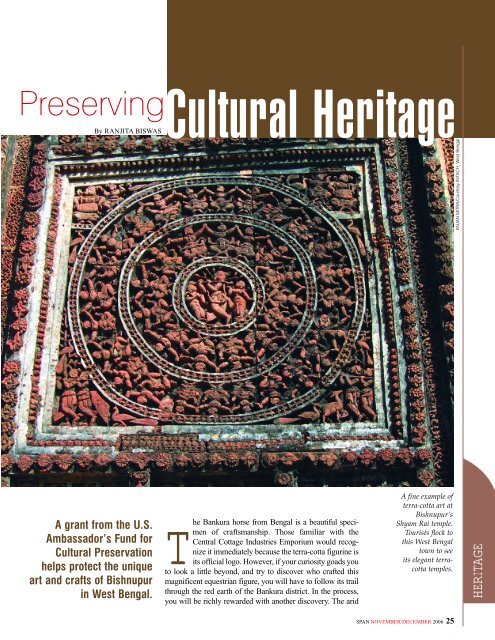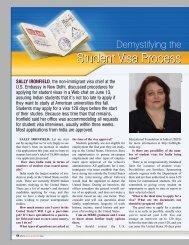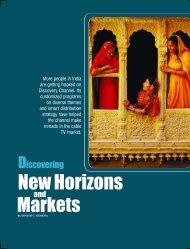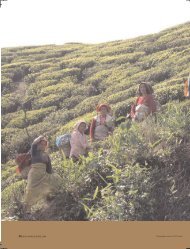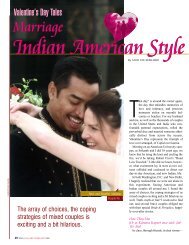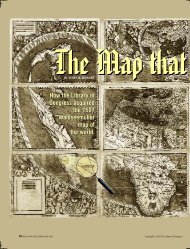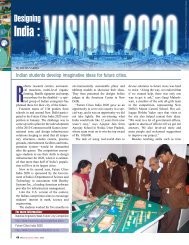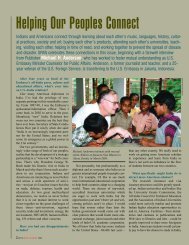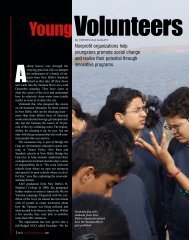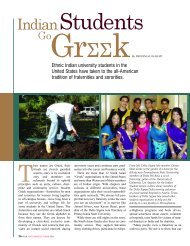Preserving Cultural Heritage
Preserving Cultural Heritage
Preserving Cultural Heritage
You also want an ePaper? Increase the reach of your titles
YUMPU automatically turns print PDFs into web optimized ePapers that Google loves.
<strong>Preserving</strong><br />
By RANJITA BISWAS<br />
A grant from the U.S.<br />
Ambassador’s Fund for<br />
<strong>Cultural</strong> Preservation<br />
helps protect the unique<br />
art and crafts of Bishnupur<br />
in West Bengal.<br />
<strong>Cultural</strong> <strong>Heritage</strong><br />
The Bankura horse from Bengal is a beautiful specimen<br />
of craftsmanship. Those familiar with the<br />
Central Cottage Industries Emporium would recognize<br />
it immediately because the terra-cotta figurine is<br />
its official logo. However, if your curiosity goads you<br />
to look a little beyond, and try to discover who crafted this<br />
magnificent equestrian figure, you will have to follow its trail<br />
through the red earth of the Bankura district. In the process,<br />
you will be richly rewarded with another discovery. The arid<br />
A fine example of<br />
terra-cotta art at<br />
Bishnupur’s<br />
Shyam Rai temple.<br />
Tourists flock to<br />
this West Bengal<br />
town to see<br />
its elegant terracotta<br />
temples.<br />
SPAN NOVEMBER/DECEMBER 2006 25<br />
ANJAN MITRA/Courtesy INTACH, West Bengal<br />
HERITAGE
Photographs courtesy East and West Educational Society<br />
landscape holds in its womb a treasure called Bishnupur, a place<br />
that embodies Bengal’s indigenous cultural heritage.<br />
Tourists flock to this town to see the elegant terra-cotta temples<br />
that dot the landscape. But Bishnupur is not confined to<br />
architectural splendor alone. Within a compact area, the town<br />
holds many other gems of art and culture: a silk weaving tradition<br />
(the Baluchari sari with symbols of kings and queens is<br />
famous); a miniature painting style; a unique game with circular<br />
playing cards (dasavatar taas) with paintings of gods and goddesses<br />
on them; handicrafts made from bell metal and embellished<br />
conch shell, and a classical style of music known as<br />
Bishnupur gharana.<br />
<strong>Preserving</strong> Bishnupur’s artifacts and traditions in a holistic<br />
manner is of great importance and needs proper documentation,<br />
feel conservationists. It is in this context that the U.S.<br />
Ambassador’s Fund for <strong>Cultural</strong> Preservation granted $15,000<br />
last year for a project by the West Bengal chapter of the Indian<br />
National Trust for Art and <strong>Cultural</strong> <strong>Heritage</strong> (INTACH). A plan<br />
T he<br />
Ambassador’s Fund<br />
for <strong>Cultural</strong> Preservation<br />
also included a grant last<br />
year to the conservation group<br />
East and West Educational<br />
Society of Patna to fund a survey<br />
of 25 districts in Bihar to<br />
document Islamic and Hindu<br />
15th and 16th century architec-<br />
26 SPAN NOVEMBER/DECEMBER 2006<br />
Documenting Bihar’s<br />
Religious<br />
<strong>Heritage</strong><br />
ture and identify buildings for<br />
future preservation. The project<br />
will showcase the co-existence<br />
of Hindu and Islamic culture<br />
that flourished in medieval<br />
Bihar. The Khuda Bakhsh<br />
Oriental Public Library of Patna<br />
is assisting the society to<br />
organize lectures, raise public<br />
to preserve the Bishnupur art, architecture and crafts has been<br />
completed and was released on August 29 by U.S. Chargé d’affaires<br />
Geoffrey R. Pyatt in Calcutta.<br />
The Fund was established by the U.S. Congress in 2001 to help<br />
countries preserve museum collections, ancient and historic sites<br />
and traditional forms of expression. (http://exchanges.state.gov/culprop/afcp/).<br />
INTACH was started in 1984 during the Festival of<br />
India events. <strong>Cultural</strong> leaders and scholars felt that apart from the<br />
preservation efforts by the Archaeological Survey of India, there<br />
was a need for projects to preserve other monuments, living traditions,<br />
and artistic endeavors.<br />
Considering Bishnupur’s position as a living urban heritage<br />
center, and the need for preservation of its unique arts and crafts,<br />
the project aims to approach UNESCO for recognition as a<br />
World <strong>Heritage</strong> site. But for that, scientific documentation is<br />
necessary. The Ambassador’s Fund will help in this effort.<br />
“Bishnupur holds a unique place in Bengal’s cultural map. It<br />
is the only Bengali urban complex in the true sense. All other<br />
places, except Gaur and Pandua, are<br />
colonial towns,” says architect Anjan<br />
awareness and conduct workshops<br />
with nongovernmental<br />
organizations, architects and<br />
urban planners. The library has<br />
about 21,000 Oriental manuscripts<br />
and 250,000 printed<br />
books. Though founded earlier,<br />
it was opened to the public in<br />
October 1891 by Khuda Bakhsh<br />
Khan with 4,000 manuscripts,<br />
of which he inherited 1,400<br />
from his father, Mohammed<br />
Bakhsh.<br />
Above: The mausoleum of<br />
Shah Daulat at Maner.<br />
One of the finest Mughal<br />
monuments in eastern India,<br />
it was built during the reign<br />
of Emperor Jahangir.<br />
Left: An inscription<br />
on the mausoleum.<br />
Mitra, project coordinator for conservation<br />
of art, architecture and culture of<br />
Bishnupur. With the comparative distance<br />
and isolation from the more welltrodden<br />
Gangetic Plain, and banked in<br />
by the Damodar River and sal tree<br />
forests, Bishnupur has managed to<br />
retain its heritage in a pristine form.<br />
It is home to a unique tradition of<br />
handicrafts, pottery and weaving that is<br />
illustrative of Hindi, Islamic and tribal<br />
artistic innovation.<br />
Located about 150 kilometers to the<br />
west of Calcutta, Bishnupur belongs to<br />
the terrain of Rahrbhum, the land of the<br />
red soil. It was also known as Mallabhum<br />
after the ruling dynasty of the Mallas (a<br />
name that means “wrestlers” and refers to<br />
the inhabitants’ independent spirit). King<br />
Jagatmalla chose Bishnupur as the capital<br />
of his powerful kingdom in the 14th century<br />
and for four centuries art, culture and<br />
education flourished under royal patronage.<br />
This also extended to religious philosophy.<br />
The kings were greatly influenced<br />
by the Bengali Vaishnavite guru<br />
Sri Chaitanya, a follower of Krishna. The<br />
best examples of this are the terra-cotta<br />
relief panels of the temples carved with<br />
symbols of Krishna and his life story.<br />
Mitra points out that it was the ingenuity<br />
of the artisans to use local material,<br />
the red earth, and burn it in a special way<br />
to make long lasting bricks. The embellishments<br />
give the impression of stone<br />
carvings. Temples were constructed in<br />
what is known as Bangla style. The slop-
Tibetan<br />
Art<br />
Conservation<br />
ing roofs (chala) made in the likeness of thatched huts of the<br />
farmers signify a “domestication of architecture,” says Mitra. The<br />
simplest form is do-chala, or two roofs, which was later developed<br />
into more complicated forms like char-chala (four roofs),<br />
aat-chala (eight roofs), etc. Radha Binod Temple and Keshta Ray<br />
Temple are some examples of these experimentations. The Rasamancha<br />
built during King Bir Hambir’s time<br />
(1600 A.D.) is a stand-alone construction,<br />
reflecting a unique experiment to accommodate<br />
all the icons of Bishnupur during the Raas festival<br />
when, legends say, Krishna and his consorts<br />
danced on a full moon night. It has a pyramid-like<br />
roof and the building stands on a laterite<br />
plinth and the sanctum is enclosed by three<br />
successive circumbulatory galleries.<br />
Bishnupur also evolved into a seat of<br />
Sanskrit scholarship and stands at the juncture<br />
of non-Aryan and Aryan cultural traditions. The<br />
Malla kings were of tribal origin and they<br />
The Radha Shyam temple in Bishnupur.<br />
T he<br />
Sikkim Research Institute<br />
of Tibetology (earlier known<br />
as Namgyal Institute of<br />
Tibetology) in Gangtok, Sikkim,<br />
is a center for the study of<br />
Mahayana Buddhism.<br />
Ornate woodcarvings and<br />
murals decorate the interior. The<br />
altars hold images of the Buddhas,<br />
Bodhisattavas and tantric spirits.<br />
The library has one of the largest<br />
collections of Tibetan texts in the<br />
world with 60,000 books in the<br />
form of xylographs, manuscripts,<br />
printed works and the collected<br />
work of all four sects of Tibetan<br />
Buddhism.<br />
The museum section contains<br />
a vast number of ritualistic<br />
chortens, brass bells, dorjis,<br />
rosaries, rare tankhas and 200<br />
icons and prized objets d’art.<br />
A grant of $35,000 from the<br />
Ambassador’s Fund aided a<br />
preservation effort that was<br />
completed in 2004.<br />
retained the link. Even Durga Puja, the most important festival for<br />
the Bengalis, has elements of tribal culture as worshipped here.<br />
Two hundred years ago, the Mallas also experimented with rainwater<br />
harvesting to provide for people of the arid region. The great<br />
tanks, which local people call “bandhs” are still existant and an<br />
integral feature of Bishnupur. The Lal Bandh, or the red tank, is the<br />
best known.<br />
The U.S.-funded project to help document all<br />
these living traditions has also involved local<br />
people and created a lot of excitement.<br />
“Documentation is not enough, mainstreaming<br />
is necessary so that the tradition lives on,” says<br />
Mitra, so the local people will also take pride in<br />
the preservation of their cultural heritage.<br />
Mainstreaming will attract more tourists from<br />
India and abroad and help make the preservation<br />
project sustainable in the long run.<br />
SUVOMOY MITRA/Courtesy INTACH, West Bengal<br />
Artifacts at the Sikkim Research<br />
Institute of Tibetology in<br />
Gangtok, which is a center for the<br />
study of Mahayana Buddhism.<br />
Ranjita Biswas is a Calcutta-based freelance<br />
journalist who also translates literature and writes<br />
fiction.<br />
SPAN NOVEMBER/DECEMBER 2006 27<br />
Photographs by KARUNA SINGH


